The Samsung 850 EVO 4TB SSD Review
by Billy Tallis on July 11, 2016 10:00 AM ESTMixed Random Read/Write Performance
The mixed random I/O benchmark starts with a pure read test and gradually increases the proportion of writes, finishing with pure writes. The queue depth is 3 for the entire test and each subtest lasts for 3 minutes, for a total test duration of 18 minutes. As with the pure random write test, this test is restricted to a 16GB span of the drive, which is empty save for the 16GB test file.
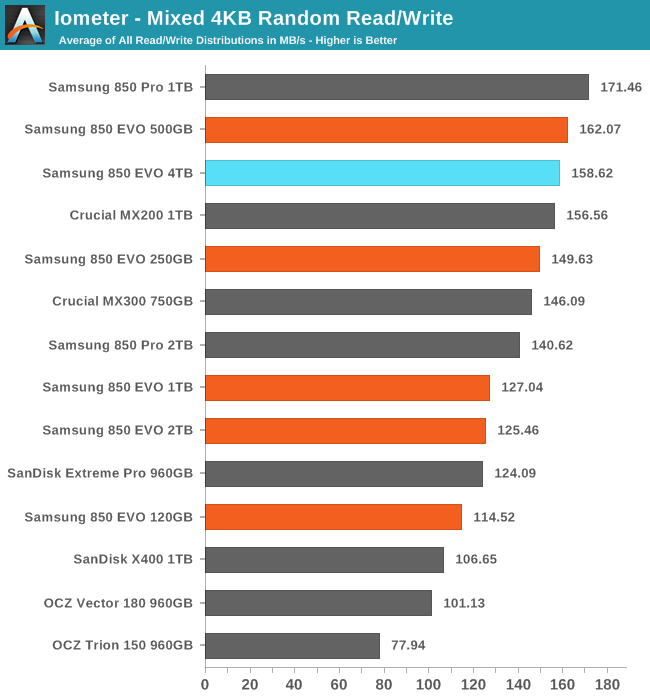
The mixed random I/O performance of the 4TB 850 EVO is much better than the other large 850 EVOs, putting te 4TB model close to the top of the chart.
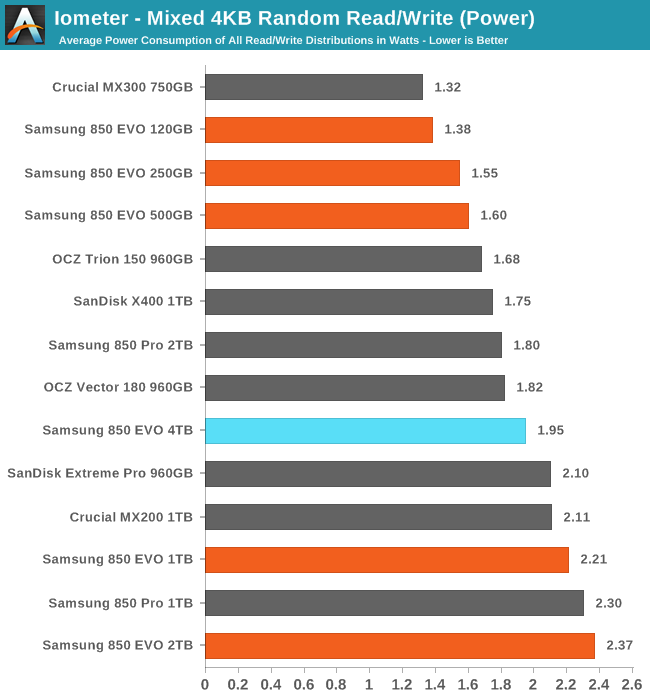
The 4TB 850 EVO also manages a large reduction in power usage as compared with the 1TB and 2TB 850 EVOs, making the 4TB much more efficient.
 |
|||||||||
Unlike the other 850 EVOs, the 4TB never loses performance as the proportion of writes in the test workload increases. Meanwhile, the power draw is essentially constant until near the end of the test.
Mixed Sequential Read/Write Performance
The mixed sequential access test covers the entire span of the drive and uses a queue depth of one. It starts with a pure read test and gradually increases the proportion of writes, finishing with pure writes. Each subtest lasts for 3 minutes, for a total test duration of 18 minutes. The drive is filled before the test starts.
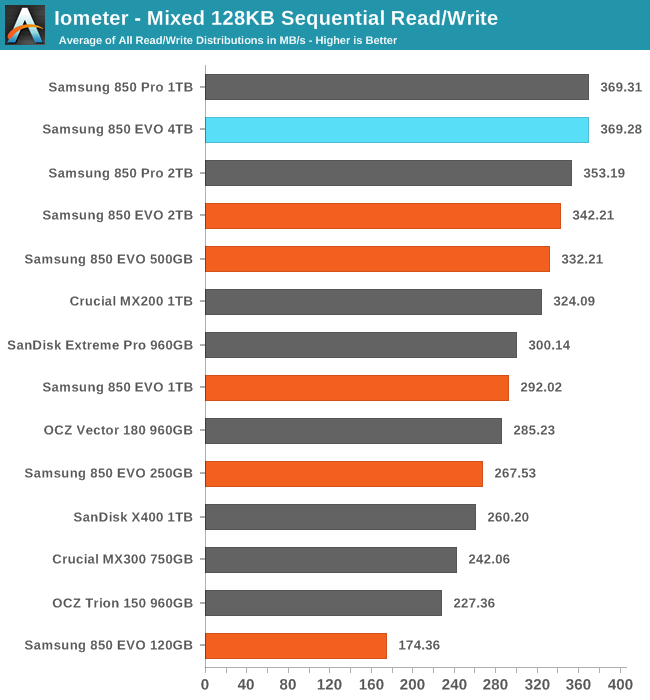
The 4TB 850 EVO is essentially tied for the best mixed sequential read and write performance.
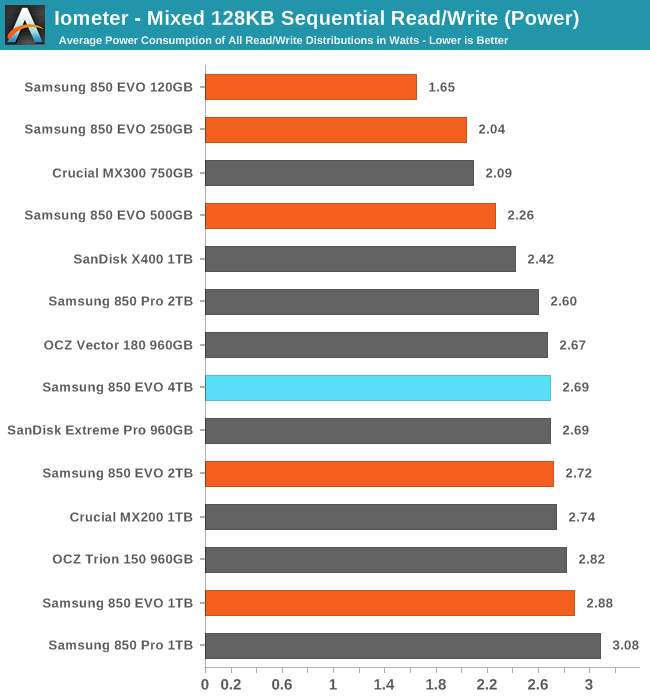
The 4TB 850 EVO averages using slightly less power than the 2TB model, and it is one of the most efficient of the large drives.
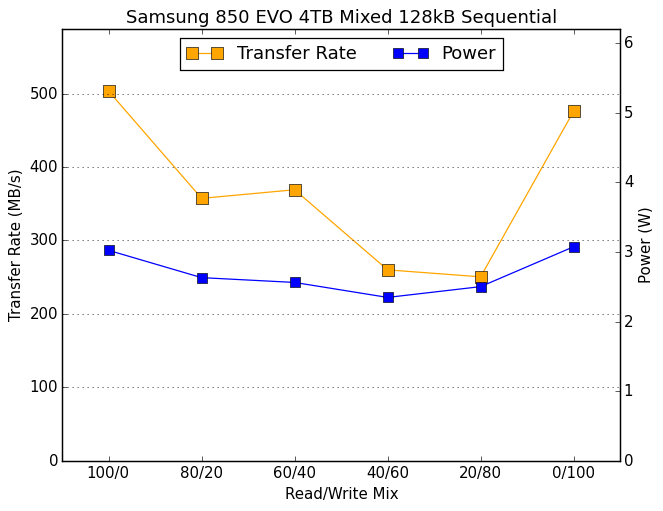 |
|||||||||
The usual pattern is for performance on this test to resemble a bathtub curve, but the 2TB 850s and the 4TB 850 EVO don't lose as much of their performance during the first half of the test, leading them to bottom out much later than most other drives.










145 Comments
View All Comments
Enigmatica - Monday, July 11, 2016 - link
Silh is right. My DAW system has 64GB of RAM and all of my samples are stored on a 400GB Intel PCIe NVME drive. I'm only a hobbyist but my set of samples is well into the 200GB range. Pros with all of the gear can easily break 1+ TBddriver - Monday, July 11, 2016 - link
Pros are actually invested in making music than obsessing with sample hoarding ;)NI KOMPLETE is 100 GB and it has pretty much everything you are ever going to need. Naturally, that means actual analog instruments. A lot of mediocre pseudo musicians obsess on hoarding what is not instrument samples but ready to use loops they can play and imagine they are doing music. The format of distribution of that stuff is as stupid as it is itself - since it is not really live performance and usually synthesized sound, it could just as well be distributed as midi + synthesizer presets, and take kilobytes rather than gigabytes - a million times less space...
smilingcrow - Monday, July 11, 2016 - link
Classic “I know what’s best for everybody” rant by someone that fails to understand the topic they are discussing.DPUser - Monday, July 11, 2016 - link
Smilingcrow is right on point here. While ddriver's words may accurately convey the mindset of a certain subset of "musicians" using computers, VI orchestrators and pro producers in many genres are not just using loops; describing these writers, arrangers, performers and engineers as "pseudo musicians" indicates a complete lack comprehension as to how these extremely talented folks work.And while is NI Komplete is wonderful, it is not (yet, if ever) the be all and end all. Incredible VIs are being developed every day by other developers, bringing new levels of fidelity and expression, making greater demands on system real-time performance and soaking up ever-increasing swaths of storage space.
Silh - Monday, July 11, 2016 - link
Have a look at some of the professional orchestral libraries. These are not loops, or instrument runs, but individual note samples, recorded with multiple articulations, velocity layers, different mic positions, etc. You're looking at at 300GB+ for, say, just the strings. VSL's full orchestra comes in about 1TB if you put everything together (and priced waaaaaaaay out of what I can afford).Daniel Egger - Monday, July 11, 2016 - link
RAW Photo editing is harmless: you import all data once and from then on it's mostly reading data. Even if you're a pro you'll have a hard time filling 4x64GB cards a day and you certainly won't sustain that throughout a year. So even if you believed in that segment-my-ass 300TB endurance figure you'll be using it for 3 or 4 years...ddriver - Monday, July 11, 2016 - link
Sure, editing involves mostly reading, you edit the photos then throw away the changes. But even then, photoshop will generate tens of gigabytes of temporary scratch files ;)smilingcrow - Monday, July 11, 2016 - link
A prosumer would be using a separate scratch disk with Photoshop though if they wanted top performance.Impulses - Monday, July 11, 2016 - link
Cheap(er) SATA drives for RAWs here (2x1TB EVO atm), SM951 for the apps and their libraries/scratch.mapesdhs - Wednesday, July 13, 2016 - link
Keep posting your sensible example config, I like that. 8)